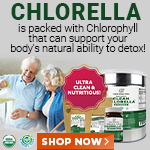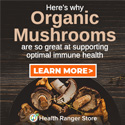
Beware: Adulteration of Essential Oils, Part II
Monday, December 07, 2009 by: Angela Eksteins
Tags: essential oils, health news, Natural News
- European Court of Justice: Healthcare professionals who promoted or administered COVID-19 vaccines are CRIMINALLY LIABLE for any harm caused
- Newly released JFK files reveal Pentagon's role in creating Lyme disease and covid in the same lab
- Oncologist warns of ‘terrifyingly aggressive’ cancers in children, linked to immune suppression from COVID vaccines
- Ancient kitchen secrets REVEALED: How garlic, ginger and green onions fight cancer and heart disease
- Britain’s descent into police state censorship: Parents raided for questioning their daughter’s school system online
- NIH study, buried for decades, reveals that Flu Shots INCREASE elderly deaths, not prevent them
- COVID-19 scandal linked to CANCER SURGE: Billionaire researcher sounds alarm
- DARPA: The shadowy innovator behind the world’s most advanced military technologies
- “Old Man in a Chair”: The COVID-19 pandemic was a carefully orchestrated scheme for global control
- Decentralize TV: Dr. Leonard Coldwell reveals shocking, heavily censored truths about CANCER, healing and the medical mafia complex
- Musk targets “strangely wealthy” lawmakers in DOGE probe, names Pelosi, McConnell, Schumer
- RFK Jr. is reforming Americans’ health: A shift in power and paradigm
- Utah governor allows ban on LGBT pride flags in public buildings and schools, will take effect without his signature
- Cinnamon plays a critical role in diabetes management
- FRAUD ALERT: Details DEMOCRATS do NOT want you to know about the $40 BILLION wasted on Fed-loaded credit cards cancelled by DOGE
- Scientists unveil breakthrough method to eliminate "Forever Chemicals" from water, transforming waste into graphene
- RFK Jr. is pushing Big Pharma ad ban - and corporate media is panicking
- Massive egg substitution recall: Bleach contamination sparks nationwide concern
- Newly released JFK files reveal Pentagon's role in creating Lyme disease and covid in the same lab
- CDC finally halts $11 billion COVID funding scam as health officials admit the ‘pandemic’ was a fraud
- Analysis: The coming economic collapse, a mass uprising and Trump's three secret weapons to halt the growing revolt
- Kiss Your Genetic Privacy Good-Bye! 23andMe Gets Green Light to Sell Your Intimate Genetic Details to Anyone They Want
- Dr. Suzanne Humphries makes bombshell appearance on Joe Rogan podcast, exposing vaccine industry deception back to POLIOMYELITIS
- DEADLY DECEPTION: How COVID vaccines increased mortality rates and why authorities hid the truth
- Woman contracts WORLD'S DEADLIEST VIRUS after unknowingly being given the WRONG VACCINE
- Oncologist warns of ‘terrifyingly aggressive’ cancers in children, linked to immune suppression from COVID vaccines
- Here are TEN all-natural ways to protect your garden without using harmful chemicals
- Black cumin seed oil emerges as a powerful ally against breast cancer and chronic inflammation
- The hidden dangers in your kitchen: How cooking methods impact diabetes, cancer and aging
- Trump's greatest betrayal so far: Accelerating Middle East wars, silencing dissent, and serving Zionist masters
- Senate Democrats deny censorship industrial complex existed, defend government's role in silencing dissent
- Sugar-free deception: Artificial sweeteners hijack hunger signals, fuel obesity epidemic, study warns
- “Independent” anti-Russia outlet MEDUZA faces COLLAPSE as US funding dries up
- NIH study, buried for decades, reveals that Flu Shots INCREASE elderly deaths, not prevent them
- The Health Ranger releases “Vaccine Zombie” song and music video, using AI-animated zombies for the music video
- Discovery of vast underground city beneath Giza pyramids challenges human history
- Newly released JFK files reveal Pentagon's role in creating Lyme disease and covid in the same lab
- California's social media censorship law struck down: A victory for free speech or a threat to online safety?
- EPA advisor admits the agency is funneling billions to climate groups ahead of Trump’s return to White House
- The Health Ranger releases “Vaccine Zombie” song and music video, using AI-animated zombies for the music video
- Dr. Mike Yeadon releases 15-minute testimony - WATCH - about genocidal intent of COVID “vaccines”
- Florida takes a stand: DeSantis proposes permanent ban on mRNA vaccine mandates
- Mike Adams releases country western hit single: Goin’ Back in Time is Comin’ Home
- “Why we influenced the 2020 elections”: Facebook files reveal the coordinated effort to bury the Hunter Biden laptop story
- Unpacking the Lies That We’ve Been Fed – new song and music video released by Mike Adams, the Health Ranger
- House Intelligence Committee calls for the ARREST and PROSECUTION of Dr. Anthony Fauci
- The pandemic as a tool for INDOCTRINATION: Understanding “The Indoctrinated Brain” by Dr. Michael Nehls
- Rep. Nancy Mace introduces bill to ban biological males from female facilities on federal property
- Mike Adams releases music poetry sensation: A Child of God
- Sugarcane extract superior to cholesterol-lowering drugs?
- Survival 101: Effective EMF blocking techniques
- Michigan sheriff announces criminal investigation into 2020 election crimes, Dominion Voting Systems
- Peter Rost exposes Big Pharma corruption in his book “The Whistleblower: Confessions of a Healthcare Hitman”
- Migrants are taking advantage of recent hurricanes to scam residents and loot their homes
- Red Cross issues warning to stop blood plasma donations from vaccinated people
- Scientists confirm: GENIUS brain function can be spontaneously unleashed in humans without any apparent cause
- EPA advisor admits the agency is funneling billions to climate groups ahead of Trump’s return to White House
- HYSSOP: What research reveals about the health benefits of this ancient holy herb
- Two containers with completed ballots fall out of truck in Florida
- Fully vaccinated about to see “tsunami” of illness and death, warns virologist
- Global leaders unite to clamp down on “misinformation” with UN-backed Cascais Declaration
- BREAKING: 2025 NDAA authorizes mandatory military draft of WOMEN across America… as Pentagon pursues global NUCLEAR war with both Russia and China at the same time
- Michael Yon warns of a ZIONIST TAKEOVER in Trump’s second administration
- BOMBSHELL: DNA testing kits are a SCAM to develop ethnic-specific bioweapons
- Ozempic and Wegovy weight loss drugs are injectable LIZARD VENOM PEPTIDES that may unleash a devastating wave of organ failure… side effects align with symptoms of SNAKE BITES
- Israeli soldiers accused of even more torture and abuse in the West Bank
- These 13 countries just signed an agreement to engineer a global FAMINE by destroying food supply
- NASA admits that climate change occurs because of changes in Earth’s solar orbit, and NOT because of SUVs and fossil fuels
- RFK Jr. clears key hurdle: Sen. Susan Collins backs controversial HHS nominee, signaling a new era for health policy
- Sermon 30: How Jesus reveals Caesar’s FAKE CURRENCY and FALSE AUTHORITY
- Coriander seeds: Ancient medicine backed by modern science
- Arizona officials claim Maricopa County needs 10-13 days to tabulate results of the election
Aromatherapists believe pure essential oils contain the natural 'life force' or 'essence' of a plant, and there are many unidentified components present which science cannot imitate. These components, existing as a 'whole', give each essential oil its own unique, special qualities.
"Buchbauer (1998) maintains that each constituent of an essential oil contributes to the beneficial or adverse effects of the oil. I contend that changing the distribution of chiral components of oils by deliberate adulteration with racemic synthetic odourants, may in fact change the beneficial properties of the oil." (Tony Burfield 2003-2005)
Synthetic or adulterated oils lack quality."Optimum quality is paramount not only in order to get the best results, but also to avoid the risk of possible harmful side effects... organic oils are best of all" says Shirley Price, a practicing aromatherapist for over two decades and author of 5 best-selling books.
"When science removes the therapeutic molecules or components from plants or essential oils, the administered result seems to give side effects. It is now appreciated that in the whole plant, or whole essential oil, there are many apparently useless components, including several that we cannot identify. These are believed to be 'quenchers' of the side effects which therapeutic agents in isolation could, and indeed do, cause." (Shirley Price; The Aromatherapy Workbook)
Typical Forms of Adulteration Include (but aren't limited to):
1. Adding a cheaper oil (either the same or different) to a more expensive oil - e.g., lavandin is often sold under the name of lavender; the therapeutic qualities and components of each are different. In some cases, adulteration with a cheaper oil is due to the short supply of the more expensive oil.
2. Addition of alcohol - to the inexperienced nose it's difficult to notice any difference in the aroma.
3. Adding isolates obtained from other essential oils - lemon or orange terpenes are available in huge quantities at very low cost. "Terpenes, a dominant feature in most essential oils, are sometimes removed to concentrate the remaining, more desirable constituents...the terpenes often being used to adulterate another oil" says Shirley Price.
4. Adding synthetic substances (sometimes nature identical) - e.g., DPG (dipropylene glycol) is colourless and odourless; it is commonly used to bulk up lavender oil.
5. Addition of a vegetable or mineral oil - Rapeseed, a very cheap vegetable oil, has been used for this purpose.
Common Adulterations Include (but aren't limited to):
GERANIUM: often cut with palmarosa, citronella, synthetic components.
JASMINE: commonly adulterated or synthesized with ylang-ylang, benzyl acetate, indole, cinnamic aldehyde and fractions.
LAVENDER: often adulterated by acetylated lavandin, aspic, synthetic linalool, linalyl acetate and ho leaf fractions.
LEMON: addition of orange terpenes, lemon terpenes & by-products, synthetic limonene, citral, dipentene, BHA and BHT.
ORANGE (SWEET): BHA, BHT, or distilled orange oil is added, or sweet and bitter are mixed.
PATCHOULI: often cut with cedarwood, clove oil, terpenes, methyl abietate, vetiver residues, castor oil, gurjun balsam and others. The superior Indonesian patchouli oil is often blended with the cheaper Chinese oil.
PEPPERMINT: the most adulterated oil, usually with cornmint. It is difficult to detect even at 85%.
ROSE: adulteration is sophisticated and difficult to detect, often adulterated with many fractions, synthetic and natural.
SANDALWOOD: often cut with amyris, araucaria, cedarwood, castor and copaiba. It also may be diluted with glyceryl acetate, benzyl benzoate and synthetic copies with the addition of sandalwood fragrance chemicals, sandalwood terpenes.
YLANG YLANG: very easily adulterated with cananga oil, Peru balsam, copaiba, inferior fractionations and synthetics. Different grades are mixed.
Resources:
Books:
The Aromatherapy Workbook; A Complete Guide to Understanding and Using Essential Oils; Shirley Price
Aromatherapy science: A Guide for Healthcare Professionals; Maria Lis-Balchin
The Art of Aromatherapy; Robert Tisserand
Article/websites:
The Adulteration Of Essential Oils And The Consequences To Aromatherapy & Natural Perfumery Practice; Tony Burfield 2003-2005; http://www.users.globalnet.co.uk/~nodice/
http://www.beautymagonline.com/pages/essenti...
http://www.abundantlifeessentials.com/adulte...
About the author
A passionate advocate for organic living and personal empowerment, Angela hopes to inspire others to live a healthy, wealthy life of purpose.Angela's expertise is organics, meditation & alternative healing techniques and philosophies. She holds qualifications in Natural Skin Care Product Development, Reiki, Thought Field Therapy, Organic Facials & Massage.
Contact: thesoulroom@gmail.com
Essential oils at FETCH.news
Get independent news alerts on natural cures, food lab tests, cannabis medicine, science, robotics, drones, privacy and more.
Take Action: Support Natural News by linking to this article from your website
Permalink to this article:
Embed article link: (copy HTML code below):
Reprinting this article:
Non-commercial use OK, cite NaturalNews.com with clickable link.
Follow Natural News on Facebook, Twitter, Google Plus, and Pinterest
Science News & Studies
Medicine News and Information
Food News & Studies
Health News & Studies
Herbs News & Information
Pollution News & Studies
Cancer News & Studies
Climate News & Studies
Survival News & Information
Gear News & Information
News covering technology, stocks, hackers, and more



"Big Tech and mainstream media are constantly trying to silence the independent voices that dare to bring you the truth about toxic food ingredients, dangerous medications and the failed, fraudulent science of the profit-driven medical establishment.
Email is one of the best ways to make sure you stay informed, without the censorship of the tech giants (Google, Apple, Facebook, Twitter, YouTube, etc.). Stay informed and you'll even likely learn information that may help save your own life."
–The Health Ranger, Mike Adams












































